SCERT AP 7th Class Science Study Material Pdf 8th Lesson Wonders of Light Textbook Questions and Answers.
AP State Syllabus 7th Class Science 8th Lesson Questions and Answers Wonders of Light
7th Class Science 8th Lesson Wonders of Light Textbook Questions and Answers
Improve Your Learning
I. Fill in the blanks.
1. Image formed by convex mirror is erect, small and _______
2. Infinite number of images are formed between two mirrors if they are kept at an angle of _______
3. Dentists use _______ mirror to see inner parts of teeth.
4. Image that cannot be obtained on screen is______
Answer:
1. virtual
2. 0°
3. concave
4. virtual
II. Choose the correct answer.
1. In periscope, the angle between two plane mirrors is
a) 0°
b) 30°
c) 45°
d) 60°
Answer:
a) 0°
2. If two plane mirrors are kept at an angle of 180° between them. Then the number of
a) 1
b) 2
c) 3
d) 4
Answer:
a) 1
3. Which of the following is not the property of image formed by a plane mirror?
a) Same size
b) Real
c) Lateral inversion
d) Erect
Answer:
b) Real
4. If a light ray falls on plane mirror along the direction of normal, then the angle of reflection will be
a) 90°
b) 45°
c) 0°
d) 180°
Answer:
a) 90°
![]()
5. Which form clear image among the following?
a) Paper
b) Cloth
c) Card board
d) Plane mirror
Answer:
d) Plane mirror
III. Match the following.
| A) Reflections from Ice pieces | 1. Regular reflection |
| B) Reflections from still water | 2. Irregular reflection |
| C) Reflectors in head lights | 3. Blue light |
| D) Rear view mirrors | 4. Concave mirror |
| E) Light which causes damage to retina | 5. Yellow light |
| 6. Convex mirror |
Answer:
| A) Reflections from Ice pieces | 2. Irregular reflection |
| B) Reflections from still water | 1. Regular reflection |
| C) Reflectors in head lights | 4. Concave mirror |
| D) Rear view mirrors | 6. Convex mirror |
| E) Light which causes damage to retina | 3. Blue light |
IV. Answer the following questions.
Question 1.
What is reflection of light? Explain with an example.
Answer:
- The process of bouncing back of light rays into the same medium after falling on a smooth or rough surface from the light source is called “reflection of light”.
Example: - Take a plane mirror and stand in front of a building in open space during the day. Let the sunlight falls on the mirror. Now rotate the mirror in such a way that a spot of light falls on the wall of building.
- In the above activity, light rays fall on the mirror bounced back. This process of bouncing back of light rays in the same medium after hitting the surface of an object is called reflection.
Question 2.
Write the laws of reflection of light.
Answer:
There are two laws of reflection :
- First law of reflection : Angle of incidence is equal to angle of reflection.
- Second law of reflection : The incident ray, reflected ray and normal to the surface are present in the same plane. Incident and reflected rays are on either side of normal.
Question 3.
Why should we keep the mirror strips in the Periscope parallel to each other? What happens if they are not parallel?
Answer:
- We should keep the mirror strips in the Periscope parallel to each other. The image of an object formed on the first mirror reflects exactly on the second mirror and then we can see the image. It is possible when the mirror strips in the Periscope parallel to each other.
- If they are not parallel, the image of an object formed on the first mirror does not reflects on the second mirror and we cannot see the image through the second mirror.
![]()
Question 4.
What precautions do you take while getting the image of burning candle using a mirror?
Answer:
- Keep the candle as its flame is in the line of the mirror.
- Keep the mirror as its plane opposite to the screen.
- Do the experiment in a dark room.
- Take care while handling the candle with flame.
Question 5.
Write the properties of images formed by concave mirror.
Answer:
The properties of images formed by concave mirror.
- It can form both real and virtual images.
- It produces erect and inverted images
- It also produces small same size and bigger images depending on the position of object in front of it.
Question 6.
Draw the diagram show regular reflection and diffused reflection of light.
Answer:

Question 7.
Where do you find multiple images formed by plane mirrors in your day-to-day life?
Answer:
- In sweet shops mirrors are arranged in such a way that multiple images of sweets can appear.
- In saloon and beauty parlours mirrors are arranged in such a way that the customers can view his images in all directions.
- In bathrooms and dressing rooms also, we can observe multiple images.
- In Kaleidoscope we can observe multiple images.
Question 8.
Where do you find irregular reflections in your daily life?
Answer:
We can find irregular reflections on unpolished marbles floors, scratched steel vessels, broken mobile screens, disturbed water surfaces, and on the rough surfaces of plastic sheets, metal sheets, etc.
Question 9.
Write the applications of spherical mirrors in daily life.
Answer:
Applications of concave mirrors:
- Concave mirrors are used by ENT doctors as Head Mirrors.
- Dentists also use concave mirrors to get a bigger image of the teeth.
- Eye specialist using a special instrument called Ophthalmoscope. It is fitted with a concave mirror having a small hole near its center.
- Concave mirrors are used to reflectors in a torch light or the headlights of vehicles.
- These are used in microscopes.
Applications of convex mirrors:
- Convex mirrors are used as Rear-view mirrors in vehicles.
- Convex mirrors are also used at the junctions of roads.
- Convex mirrors are used at ATM machines.
- Convex mirrors are used for security purpose at factories, offices, etc.
7th Class Science 8th Lesson Wonders of Light InText Questions and Answers
7th Class Science Textbook Page No. 16
Question 1.
What do you observe in the picture? Mention the different objects in the scenery.
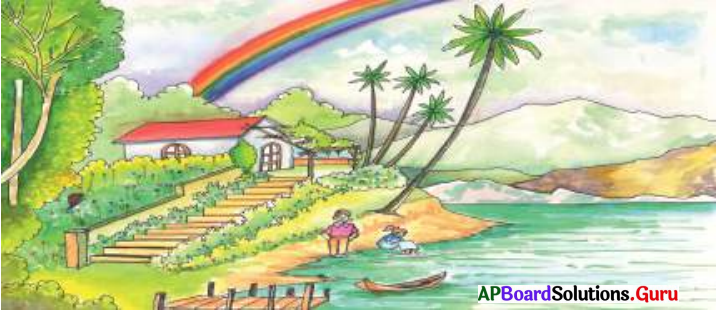
Answer:
Trees, river, hills, rainbow, steps, boat, a boy, a girl, butterfly, water, plants, wooden bridge.
Question 2.
Can we see all these objects during night time?
Answer:
No, we cannot see all these objects during night time.
7th Class Science Textbook Page No. 17
Question 3.
Where does the light come from?
Answer:
Light comes from different objects called sources of light.
Ex : Sun, candle, tubelight.
![]()
Question 4.
Name some sources of light around you.
Answer:
Sun, candle, tubelight, bulb, torch light, match box etc .
Question 5.
Do these sources release light on their own?
Answer:
Sources like sun, stars emit light on their own.
Sources like bulb, torch light, candle do not emit light on their own.
Question 6.
Can you give some other examples for natural sources of light?
Answer:
The moon, stars and the sun.
Question 7.
Do you know how this light travel from the source?
Answer:
Actually, light is not a single ray, but a bundle of rays- This bundle of light rays are called beam of light rays. .
Question 8.
What do we call the path of light?
Answer:
The direction or path along which light travels is called a ray of light.
7th Class Science Textbook Page No. 18
Question 9.
How are we able to see the objects?
Answer:
The light fall on the objects and reflects and reach to our eye.
Question 10.
Is only light enough to see the objects around us?
Answer:
Yes, light is enough, but reflected light should reach our eye.
7th Class Science Textbook Page No. 19
Question 11.
In the activity-2, is there any reflection from the reflected light?
Answer:
Yes, there is reflection from the reflected light.
7th Class Science Textbook Page No. 23
Question 12.
We are able to see our image in the mirror. Can we catch our image bn screen?
Answer:
No. We cannot catch our image on screep.
7th Class Science Textbook Page No. 24
Question 13.
Are the images formed by plane mirrors real or virtual?
Answer:
Plane mirror forms virtual image.
Question 14.
Have you observed the arrangement of plane mirrors in a sweet shop? How many images did you find?
Answer:
Yes, I have observed the arrangement of plane mirrors in a sweet shop. So many images are formed.
7th Class Science Textbook Page No. 25
Question 15.
How many images are formed when the angle between two mirrors is zero?
Answer:
Number of images (n) = (360°/θ) – 1= ∞ , from the formula, we can find infinite number of images are formed. –
7th Class Science Textbook Page No. 26
Question 16.
Have you ever seen your image in rearview mirror of your father’s, motor cycle?
Answer:
Yes.
Question 17.
Is it same as the image seen in the mirror of your dressing table?
Answer:
No
Question 18.
What difference did you observe?
Answer:
Image is small in and closure.
Question 19.
What may be the reason for the difference?
Answer:
May be shape of the surface of the mirror.
![]()
Question 20.
Touch the surface of the rearview mirror. Is it same as plane mirror?
Answer:
No. It is not same as plane mirror. It is in curved in shape.
7th Class Science Textbook Page No. 28
Question 21.
Do you know the use of spherical mirrors in your daily life?
Answer:
Concave mirrors are used by dentists, ophthalmologists, ENT doctors and also in head lights of vehicles. Convex mirrors are used as rear view mirrors in vehicles and safety mirrors at curved roads.
7th Class Science Textbook Page No. 29
Question 22.
Have you ever observed the surface of reflection in a torch light or the headlights of vehicles?
Answer:
Yes, they are spherical in shape.
7th Class Science Textbook Page No. 30
Question 23.
Can you recognize the mirrors used beside the drivers in vehicles?
Answer:
These are convex mirrors.
Question 24.
Can you now recognize the characteristics of image from rear view mirror?
Answer:
Erect, virtual and smaller images are formed.
Question 25.
Do all the objects reflect the light rays falling on it?
Answer:
No.
Question 26.
Do you know why did paper burnt with a magnifying glass?
Answer:
The paper burned as the magnifying glass concentrated the sun’s rays at one place on the paper.
![]()
Question 27.
Doesthe magnifying glass reflect the light falling on it?
Answer:
No.
Think & Respond
7th Class Science Textbook Page No. 23
Question 1.
Deepak saw a vehicle on the road. He was surprised to see that the word ![]() on it. What was that word? Why was it written in a strange manner?
on it. What was that word? Why was it written in a strange manner?
Answer:
- The word is AMBULANCE.
- AMBULANCES are emergency vehicles.
It is important to give way to ambulances.
The drivers can see the rear coming vehicles through the rear view mirror of the vehicles. Objects and letters appear in reverse means in left right inversion in mirrors. So letters in the wf>rd AMBULANCE also appear in reverse and cannot understand the word to the drivers.
If the word is written in reverse (as in mirror image) on the ambulance, it appears normally and readably. Drivers can read the word AMBULANCE and give a way to ambulance immediately.
Activities and Projects
Question 1.
Large sized concave mirrors are used to focus sun rays in solar cookers and solar heaters.Make a solar cooker of your own by using this principle and exhibit in your school science fair.
Answer:

Making of solar cooker :
- A concave mirror focuses parallel sun rays at the focal point of the mirror.
- So with a small concave mirror .we can heat up and burn paper.
- In the same way make a big concave mirror to heat up a vessel.
- Make a wooden/ iron frame in the shape of TV dish.
- Cut acrylic mirror sheets into 8 or 12 pieces in the shape of isosceles triangles with a height equal to the radius of dish antenna.
- The bases of 8 or 12 triangles together make the circumference of the dish.
- Stick the triangle mirrors to the dish.
- Our solar heater/cooker is ready.
- Arrange it so that concave part faces sun.
- Find its focal point and place a vessel at that point.
- It will get heated. We can even cook rice in that vessel.
Question 2.
Prepare a report by collecting data on the uses of spherical mirrors.
Answer:
Spherical mirrors are two types : They are 1) concave mirror 2) convex mirror.
1) Concave mirror :
Concave mirrors have a smooth curved surface inwards. Light rays are converged at one point by a Concave mirror. Real and virtual images can form the concave mirror.
The applications of concave mirror in our daily life :
Dentists :
Concave mirrors are used by dentists in the examination of teeth.
ENT doctors:
These are used by ENT doctors to examine the body parts.
Shaving mirrors :
During shaving, the concave mirror forms an enlarged and erect image of the face when the mirror is held closer to the face.
Optical instruments:
Ophthalmoscope concave mirrors are used in optical instruments such as Ophthalmoscope.
Astronomical telescopes:
These are used in telescopes and other devices. Headlights : Concave mirrors are widely used in headlights of automobiles and motor vehicles, torchlights, railway engines, etc. as reflectors. The light source is placed at the focus of the mirror, so after reflecting the light rays travel over a huge distance as parallel light beams of high intensity.
Solar cookers :
Concave mirrors are also used in solar cookers. Concave mirrors are also used in satellite dishes, electronic microscope, visual bomb detectors, etc.
2) Convex mirror .
Convex mirrors have a smooth curved surface outwards. Light rays are diverged at one point by a Convex mirror. Only virtual images can form the convex mirror.
The applications of convex mirror in our daily life.
Rear-view mirrors:
These are convex mirrors. These mirrors form images of objects spread over a large area. So, these help the driver to see the traffic behind them. Hence these are used as Rear-view mirrors.
Road safety:
Convey mirrors kept at the corners of curved roads to avoid accidents. Convex mirrors form images of vehicles on both sides of curved road. These mirrors are also used at the mnctions of roads.
![]()
Question 3.
Make a list of objects in your school and home, that works like a mirror. Make a report why they work like that.
Answer:
- Plane mirror : It has plane surface. So it reflects the light.
- Water surface : It has plane surface, when it was stable. So it reflects the light.
- Tiles of floor : It has plane surface. So it reflects the light.
- Almara : It was painted and has a smooth plane. So it reflects the light.
- Steel plate : It has a smooth plane. So it reflects the light.
- Concave and convex mirrors : It has plane surface. So it reflects the light.
- Computer screen : It has plane surface. So it reflects the light.
- Steel spoon : It has plane surface. So it reflects the light.
Question 4.
Take an empty tooth paste box and two mirror strips of required size and make a periscope.
Answer:
Collect the following materials to make your own periscope.
- Empty tooth paste box, two mirror strips, scale, pencil, blade, gum.
- Take an empty tooth paste box.
- Close the ends and draw two squares at both the ends by using scale and pencil.
- Draw diagonals to the square boxes, such that the two diagonals facing each other.
- Make two slits with the help of blade along the diagonals.
- Make sure that the size of mirror should be equal to the length of slits.
- Fix the mirror strips in the slits in such a way that reflecting surfaces of mirror strips face pach other.
- Fix the mirror strips firmly to the box by using gum.
- Cut out two windows on the narrow sides such that the windows should open directly on the reflecting surfaces of the mirror strips. Now the Periscope is ready.
Activities
Activity – 1
Question 1.
Write an activity to show the following type of light rays,
i) Parallel beam of light rays
ii) Converging beam of light rays
iii) Diverging beam of light rays
Answer:
i) Parallel beam of light rays:
Light rays which travel parallel to each other are called Parallel beam of light rays. To understand about parallel beam of light rays observe situation 1.
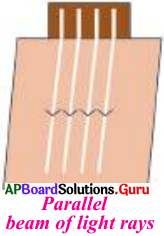
Situation-1 :
- Take a plank and cardboard.
- Make small slits on cardboard.
- Keep the cardboard on the plank perpendicular to it.
- Keep it in sunlight during afternoon as shown in figure.
- The light rays from the sun fall on the cardboard and passed through the slits.
- We can observe that the light rays are travelling parallel to each other. These are called parallel beam of light rays.
ii) Converging beam of light rays :
“Light rays which travel from different directions to meet at a point are called as Converging beam of light rays”.
To know clearly about converging beam let us observe situation 2.
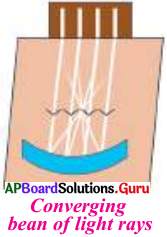
Situation-2 :
- Recall the above situation.
- Arrange an acrylic mirror in the path of light rays as shown in the figure.
- The light rays meet at a point after bouncing back from the mirror. These are called converging beam of light rays.
iii) Diverging beam of light rays :
“Light rays which travel from a source moving in different directions are called as Diverging beam of light rays.” To understand about diverging beam, let us observe situation 3.
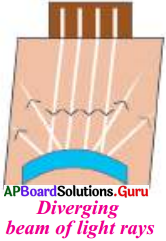
Situation-3 :
- In the above situation, arrange the acrylic mirror in the path of light rays as shown in the figure.
- After bouncing back from the mirror light rays travel in different directions
![]()
Activity – 2
Question 2.
Write an activity to Understand the reflection of light.
Answer:
“The process of bouncing back of light rays into the same medium after falling on a smooth or rough surface from the light source is called “reflection of light”. Let us understand this phenomenon with the following activity.
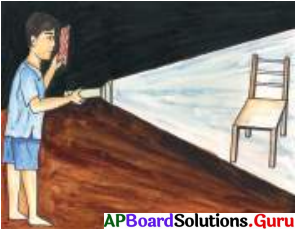
- Take a torch and enter into a dark room.
- Observe the objects in darkness. We cannot see any object.
- Switch on the torch and focus it on the objects. We can see the objects.
- Keep a card board between your eyes and object.
- Now try to see the objects. We cannot see any object. ,
- From the above activity we can conclude that objects are visible only when light falls on the objects and bounces back to the eye.
Activity – 3
Question 3.
Write an activity to understand the reflection of light.
Answer:
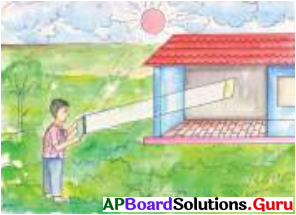
- Take a plane mirror and stand infront of a building in open space during the day.
- Let the sunlight falls on the mirror.
- Now, rotate the mirror in such away that a spot of light falls on the wall of building.
- Light rays from the sun fall on the mirror and bounced back. The spot of Light on the wall is the image of sun.
- In this activity, light rays fall on the mirror and bounced back.
- This process of bouncing back of light rays in the same medium after hitting the surface of an object is called reflection.
Activity – 4
Question 4.
Write an activity to understand the regular reflection and irregular reflection of light.
Answer:
Reflection from a smooth and shiny surface is called regular reflection.
Reflection from an irregular or uneven surface is called irregular reflection or diffused reflection.
Let us understand these from the activity below.
1) Focus the light from a source on the objects mentioned in the given table and try to get the image of the objects.
2) Record your observations in the table given.
| Object | Nature of surface of the object (Smooth and shiny/ Smooth but not shiny/ rough) | Observation (Clear image is formed/image is formed but not clear/ No image is formed) |
| 1. Plane mirror | Smooth and shiny | Clear image |
| 2. New steel plate | Smooth and shiny | Clear image/ but not clear |
| 3. Card board | Rough | No image |
| 4. Thermocol sheet | Rough | No image |
| 5. Cloth | Rough | No image |
| 6. Paper | Rough | No image |
3) From the above table it is clear that light reflects regularly from a smooth and shiny surface and irregularly from an uneven surface.
4) Reflection from a smooth and shiny surface is called regular reflection.
5) Clear images are formed in case of regular reflection.
6) Reflection from an irregular or uneven surface is called irregular reflection or diffused reflection. Images are not clear or sometimes cannot form the images at all in case of irregular reflection.
![]()
Activity – 5
Question 5.
How can you verify the laws of reflection?
Answer:
- Take a White paper and spread it on a drawing board or cardboard.
- Draw a straight-line AB at the center of paper by a pencil.
- Mark a point O at the center of AB.

- At the point ‘O’ draw a perpendicular line ON to AB.
- ON is called normal to the surface.
- ake a protractor and place it on white paper in such a way that the zero edge of the protractor coincides with the point O on AB as shown in figure.
- Mark different angles starting from 10° to 80° on both sides of ON.
- Now place a plane mirror on the line AB with the help of two clips such that the surface of the plane mirror is perpendicular to the surface of the white paper.
- Take a laser pointer and focus it on plane mirror at ‘O’ making an angle of 40° with the line ON.
- Observe the reflected ray from the mirror.
Angle of incidence Angle of reflection 1. 20° 20° 2. 40° 40° 3. 60° 80° 4. 80° 80° - The angle made by incident ray with the normal ON is called angle of incidence i.
- The angle made by the reflected ray with the normal is called the angle of reflection r.
- Focus laser pointer at different angles of incidence.
- Observe the angles of reflection in each case and tabulate the values.
From the above observations you can conclude that the angle of incidence is always equal to angle of reflection.
(OR)
![]()
This is the first law of reflection.
1) From the above activity you can also observe that Incident ray, reflected ray and normal are present in the same plane and incident, reflected rays are on either side of normal.
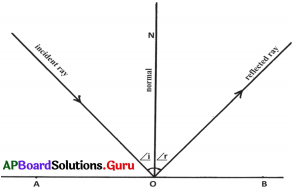
2) The incident ray, reflected ray and normal to the surface are present in the same plane and incident, reflected rays are on either side of normal.
This is the second law of reflection.
Activity – 6
Question 6.
How can you verify the following characteristics of image by plane mirror?
1) Object distance is equal to image distance.
2) Size of the object is equal to size of the image.
Answer:
Let us verify the above characteristics by the following activity.
1) Take a chess board.
2) Fix a plane mirror vertically at the one end of the chess board as shown in the figure. Place a sharpener on one of the square boxes on the chess board.
3) You can see the image of sharpener in the mirror.
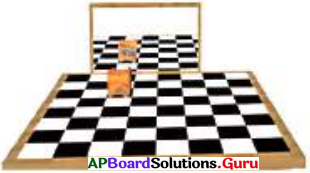
4) Count the number of square boxes between the mirror and the sharpener. At the same time count the number of square boxes between the mirror and the image of sharpener. The number of square boxes equal in both the cases.
Conclusion 1:
5) From the above activity you can conclude that the distance of the object from the mirror is equal to the distance of image from the mirror.
6) The distance of the object from the mirror is called object distance. The distance of the image from the mirror is called image distance.
7) In the above activity observe the size of object [sharpener] and image.
8) You will find that the size of image and object are equal.
Conclusion 2:
From the above activity you can conclude that the size of the object is equal to size of the image.
Activity – 7
Question 7.
How can you verify the following characteristic of image by plane mirror?
Laterally inverted image is formed, (left and right alternates)
Answer:
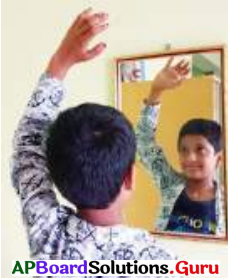
- Stand in infront of a plane mirror and raise your right hand.
- Observe the image formed in the mirror.
- Now lower the right hand and raise the left hand.
- Observe the changes you noticed in the image.
- Your right hand appears left and left hand appears right in the image.
- Such a shift of lateral side of images in opposite direction is called lateral inversion.
Conclusion:
So images formed by plane mirrors undergo lateral inversion
Activity – 8
Question 8.
How can you verify the following characteristics of image by plane mirror?
* The image formed is always virtual and erect.
Answer:
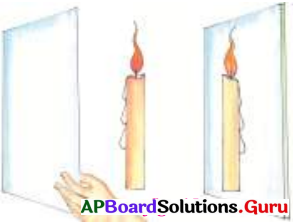
- Place a burning candle infront of the plane mirror.
- Observe the image of burning candle in the mirror.
- Now place a white paper behind the candle.
- Try to get the image of candle on paper.
- If your answer is ‘YES’, such type of image which we get on screen is called real image.
- If your answer is ‘NO’, such type of image which cannot get it on screen is called virtual image. •
- Plane mirror forms only virtual image.
- In the above activity, the image of burning candle is erected.
- We can see the erect image of the object in the mirror.
Conclusion:
Thus, we can conclude that plane mirrors form virtual and erect image.
![]()
Activity – 9
Question 9.
Write an activity to understand the relation between the arrangement of mirror and number of images.
(OR)
Derive a formula for number of images formed between two mirrors.
Answer:
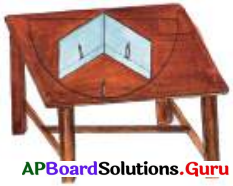
- Take a drawing board, spread a white sheet on it.
- Draw a semicircle on the white sheet.
- Mark the angles from 0° to 180° with the help of protractor.
- Take two plane mirrors of same size join them with cellophane tape as shown in the figure.
- Keep the mirrors on the semicircle such that the angle between the mirrors is 120° .
- Now bring a burning candle in between the mirrors.
- Observe the number of images formed by the two Mirrors.
- Change the angles between the mirrors from 120° to 90°, 60°, 45°, and 30° respectively.
- Observe the number of images formed in each position. Tabulate your observation.


In this way we. can derive the formula to find out the number of images formed between two mirrors.
Number of images (n) = (360°/θ) -1 where 0 is the angle between the mirrors
Activity – 10
Question 10.
How do you make a Royal Road in a Shoe Box by using plane mirror?
(OR)
How do you prepare a Fancy item by using the phenomena of multiple reflections of plane mirrors?
Answer:
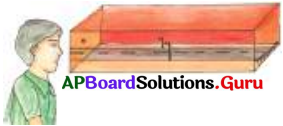
- Fix two plane mirrors on the opposite sides of a shoe box with their reflecting surfaces facing each other.
- Draw a road on the bottom of shoe box between the mirrors.
- Arrange two LED street lights on both sides of road.
- Make a small hole on mirror side of shoe box and scrape off a little of colour coating from the mirror on that place.
Observe the scenery inside the box through this hole. - Light rays from the LED fall on the first mirror and then continuously undergone multiple reflections.
- That’s why we see a long road With full of LED lights.
Activity – 11
Question 11.
How do you make a periscope by using plane mirrors?
(OR)
Make your own periscope.
Answer:
Required materials:
Empty Incense stick box [Agarbatt(box], two mirror strips, scale, pencil, blade, gum.
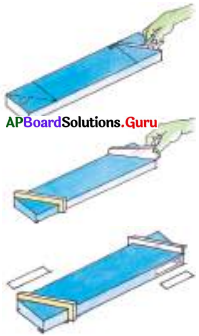
Procedure:
- Take an empty Incense stick box.
- Close the ends and draw two squares at both the ends by using scale and pencil.
- Draw diagonals to the square boxes, such that the two di-agonals facing each other.
- Make two slits with the help of blade along the diagonals.
- Make sure that the size of mirror should be equal to the length of slits.
- Fix the mirror strips in the slits in such a way that reflecting surfaces of mirror strips face each other.
- Fix the mirror strips firmly to the box by using gum.
- Cut out two windows on the narrow sides such that the windows should open directly on the reflecting surfaces of the mirror strips as shown in figure.
- Now your Periscope is ready.
- You can use this to see the objects outside the room through the window while hiding yourself in the room
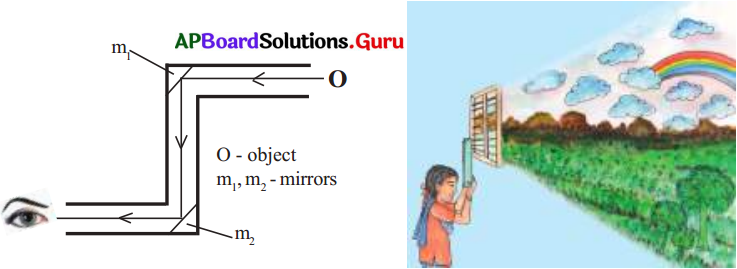
Activity – 12
Question 12.
Write an activity to understand different shapes of spherical mirrors.
Answer:

1) Take a stainless-steel serving spoon.
2) Look into it by bringing the outer bulged side of the spoon near your face.
3) Do you see your image in it? (Yes)
4) Did you observe any difference in image from what you see in plane mirror? (Yes)

10) Try to increase the distance of the spoon from your face.
11) Here the surface of the spoon act as a mirror but the surface is not plain.
12) The outer surface of the spoon is curved out like the outer surface of a sphere.
13) The inner surface of the spoon is like the part of inner surface of a sphere.
14) These mirrors are the parts of spheres. So these kinds of mirrors are called spherical mirrors.

Spherical mirrors are of two types :
- Convex mirrors (Reflecting surface bent outward)
- Concave mirrors (Reflecting surface bent inward)
Activity – 13
Question 13.
Characteristics of image formed by a concave mirror.
Take a ‘V’ shaped wooden stand. Keep a concave mirror on it. Place a lighted candle at a distance of about 50 cm in front of the mirror. Try to get clear image of the candle flame on a white screen or white paper by moving the screen towards and away from the mirror. Make sure that the screen is not placed in between burning candle and mirror.

Place the lighted candle at different distances in front of the mirror by moving it towards the mirror. Try to get clear image on screen at each position. Note your obser-vation in the table given below.
Answer:

From the above table you can conclude that a concave mirror can form real and virtual images, erect and inverted images, smaller, same size and bigger images depending on the position of object in front of it.